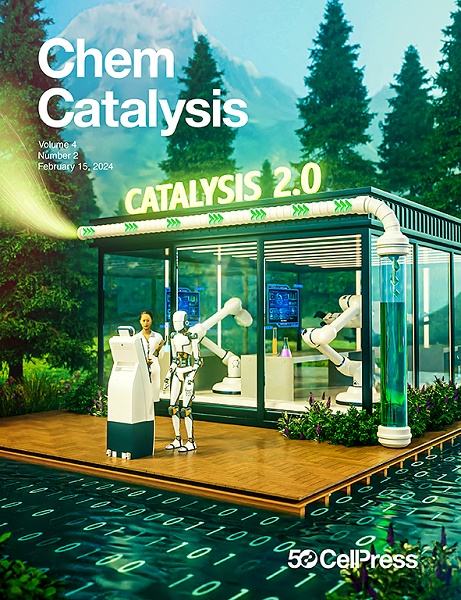Stretchable asymmetric dual-atom Cu(I) electrocatalyst for enhanced CO2 reduction to C2+ products
IF 11.6
Q1 CHEMISTRY, PHYSICAL
引用次数: 0
Abstract
Constructing precise catalytic sites and local microenvironments to achieve electrochemical CO2 conversion to valuable C2+ products remains a great challenge. Here, a porous crystalline covalent organic framework (COF) containing Br-bridged dual single-atom Cu(I) sites with an asymmetric coordination environment was rationally designed and confirmed by combining single-crystal X-ray diffraction and X-ray absorption fine structure analyses. The as-synthesized COF-based single-atom Cu catalyst exhibits exceptional performance in the electrochemical CO2 reduction reaction to C2+ products, which surpasses that of most previously reported single-atom catalysts with defined coordination structures. Operando Raman spectroscopy, theoretical calculations, and control experiments were employed to verify the mechanism behind the effectiveness of the catalyst. These investigations suggest that the flexible, asymmetrically coordinated dual-atom Cu(I) sites can lower the energy barrier for generating ∗CO and ∗COCHO intermediates, thereby promoting the formation of C–C bonds necessary for C2+ products.

可拉伸的非对称双原子Cu(I)电催化剂,用于增强CO2还原为C2+产物
构建精确的催化位点和局部微环境来实现电化学CO2转化为有价值的C2+产品仍然是一个巨大的挑战。本文通过单晶x射线衍射和x射线吸收精细结构分析,合理设计了含br桥接双单原子Cu(I)位的多孔晶体共价有机骨架(COF),并对其进行了验证。合成的cof基单原子Cu催化剂在电化学CO2还原C2+反应中表现出优异的性能,超过了以往报道的大多数具有明确配位结构的单原子催化剂。利用拉曼光谱、理论计算和控制实验验证了催化剂有效性背后的机制。这些研究表明,柔性的、不对称配位的双原子Cu(I)位点可以降低生成∗CO和∗COCHO中间体的能垒,从而促进C2+产物所需的C-C键的形成。
本文章由计算机程序翻译,如有差异,请以英文原文为准。
求助全文
约1分钟内获得全文
求助全文
来源期刊
CiteScore
10.50
自引率
6.40%
发文量
0
期刊介绍:
Chem Catalysis is a monthly journal that publishes innovative research on fundamental and applied catalysis, providing a platform for researchers across chemistry, chemical engineering, and related fields. It serves as a premier resource for scientists and engineers in academia and industry, covering heterogeneous, homogeneous, and biocatalysis. Emphasizing transformative methods and technologies, the journal aims to advance understanding, introduce novel catalysts, and connect fundamental insights to real-world applications for societal benefit.

 求助内容:
求助内容: 应助结果提醒方式:
应助结果提醒方式:


